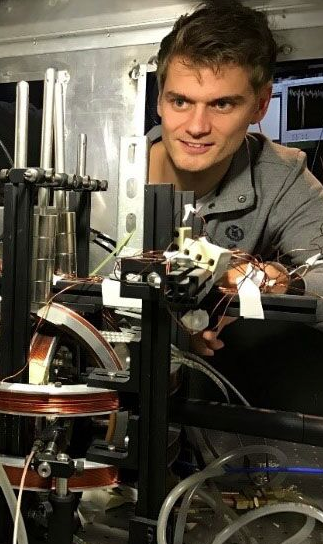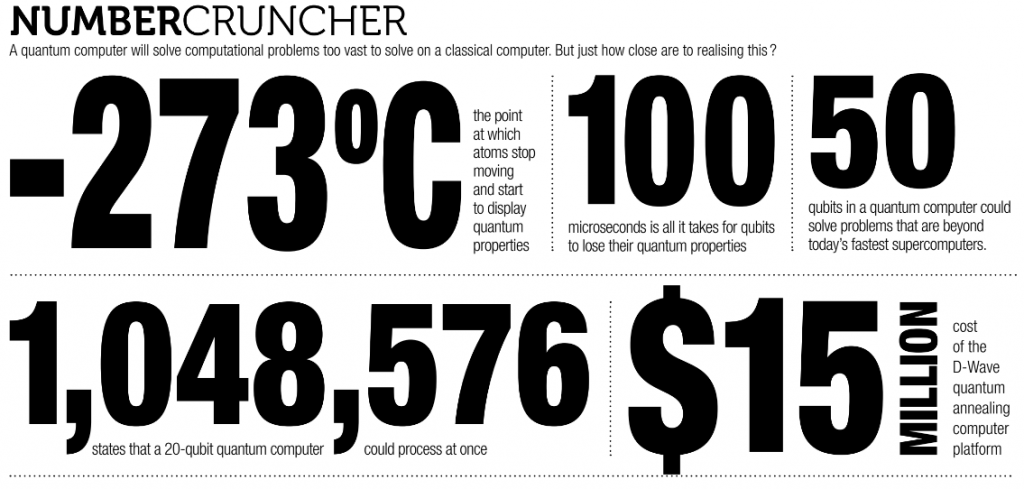The quest to go quantum
1 Apr 2019 by Evoluted New Media
Dotted around the UK, scientists are slowly but surely turning quantum research into commercial products. Jonathan Chadwick met up with a team at Sussex University who think they can beat IBM and Google at their own game…
Deep in the labyrinth of floors, corridors and doors that make up the University of Sussex’s Physics and Astronomy Department, is a set of restricted rooms operated by the university’s Ion Quantum Technology group.
Stepping inside, I am greeted by a controlled chaos of wires, computer monitors, valves, kitchen foil, and huge metal pipes leading to the ceiling.
Sussex is one of nine universities that make up a national quantum computing network, formed in 2013 as part of the UK’s government £270 million National Quantum Technologies Programme. Its mission? Commercialising the first universal quantum computer.
In the last couple of decades is we’ve become really good at taking the small quantum systems, isolating them really well and manipulating them in a very specific way
“We most certainly are some of the only people who have a clear route to how to build a large-scale quantum computer,” says Sebastian Weidt, from the university’s Ion Quantum Technology group, as we tread carefully around the room. There is a tangible sense that one errant wire or lost connection could set the team back months.
“IBM and Google are following a particular approach; we’re following a different approach where we believe we have a clear edge.”
The team are in the process of setting up a company specifically focused on building their own quantum computer in a commercial setting, working from a blueprint that it launched in 2017.
Quantum computer
Once you dispose of the model of classical physics and enter the world of quantum, unusual things start to occur.
 Sebastian Weidt, from Sussex University’s Ion Quantum Technology group. (Image: University of Sussex)
Sebastian Weidt, from Sussex University’s Ion Quantum Technology group. (Image: University of Sussex)
Conventional computers use the processing language of binary code, a language based on one of two states – zeroes or ones. But quantum mechanics allows a unit of quantum information, a qubit, to be in a state of zero, one, or both states simultaneously. This extra “coherence” state would give enormous gains in processing power over classical computers.
Quantum entanglement, meanwhile, is another aspect of the bizarre quantum world that could prove to be very useful for computation. It describes the phenomena of two particles and their properties becoming linked without physical contact with one another. In a quantum computer, this could allow data processing between two qubits to occur simultaneously.
These quantum effects potentially make a quantum computer much more powerful than any supercomputer. The work Sussex has been doing for years is to firstly show that these effects are really happening and secondly, develop technologies to scale them to a function as a quantum computer.
“In the last couple of decades is we’ve become really good at taking the small quantum systems, isolating them really well and manipulating them in a very specific way,” Dr Weidt says.
“We’ve learnt to have very good control of these small quantum systems and can therefore, for example, tell an atom exactly when it should be in two places at the same time.”
Quantum properties, such as superposition and entanglement, are easily lost through decoherence, where quantum systems are subject to "noise" in an external environment – such as fluctuations of a signal in an electric circuit – which disrupts the highly sensitive computing process. One of Weidt’s breakthroughs in his quest to scale a quantum computer is to reduce this disruption.
Trapped ion
 Mounted ion chip. (Image: University of Sussex)
Mounted ion chip. (Image: University of Sussex)
There are two leading quantum architectures upon which a quantum computer is based: superconducting electronic circuits – the approach favoured by IBM, Microsoft and Google in their efforts to build commercial computers – and trapped ion. Sussex favours the latter.
A superconducting qubit – the unit of quantum energy – is fabricated into a solid, which is naturally a very noisy environment. This makes it harder to achieve high quantum gate fidelities – the level of exactness between two quantum states – for information exchange.
Dr Weidt believes there are fundamental issues with the superconducting qubit that Sussex has worked hard to overcome. There is, for example, no working method of making the approach modular – the ability to establish a quantum link between two quantum computing modules. Also, superconducting qubits require a dilution refrigerator, a very expensive and chandelier-like cryogenic device, to keep temperatures near to absolute zero. The cooling power required to reach such temperatures is incredibly high, which limits the number of potential qubits possible in a computing structure.
“IBM and these guys … they have a dilution fridge, which is basically a million-pound machine that sits on top of their chip,” Dr Weidt says. “It’s very expensive to buy and to operate and it doesn’t have much cooling power.
Read this: Edging towards the quantum speed limit
“They have to work very carefully to make sure that everything is very well anchored and isolated to make sure that no heat gets in there otherwise the whole thing breaks. Their quantum computer doesn't work if their chip temperature rises up, whereas for us, we’re only room temperature.”
‘Together with scientists from around the world, and our outstanding scientists at Sussex, we are ready to make a large-scale quantum computer. We can make it happen.’ Read about Sussex's blue print for the world's first quantum computer: https://t.co/NveagmzA6S #WednesdayWisdom pic.twitter.com/9hWzs88FVg
— University of Sussex (@SussexUni) October 24, 2018
His confidence in his own approach is compelling – even more so given the computing giants to which he refers. And there is good reason to think he is on to something. A trapped ion approach means qubits can be created with ions that are suspended in free space using electromagnetic fields. Information can be exchanged between these ions in a shared state, often induced by lasers, or in Sussex’s case, global microwave radiation. And because ions are trapped above a surface in a vacuum environment, they’re isolated from the noisy environment.
“Trapped ion systems require a vacuum system which the superconducting qubit machines don’t need but this is a very small overhead compared to having to use a dilution refrigerator,” Dr Wedit says. “Trapped ion qubits currently hold the world record in quantum gate fidelity and this is one of the reasons why we use it.”
Despite this positive note, current quantum computer prototypes have to be operated in a specialised environment in a lab, such as the one in Sussex’s Falmer campus. They’re also only capable of handling a small number of qubits. Increasing the power and scale of a quantum computer requires more, but the more qubits that are added, the more difficult it becomes to avoid the noise.
Sussex’s solution in the form of a research paper, Resilient entangling gates for trapped ions, published in Physical Review Letters describes a new version of a quantum logic gate that protects against this infidelity.
This is just an example of why Sussex’s current mission is to work on the underlying architecture that could solve such issues, rather than joining the race to ramp up qubits that has come to define the quantum computing world in recent years.
Quantum supremacy
So, dare I ask, when will we see a genuinely quantum computer? Well, stop me if you think you’ve heard this one before, but perhaps we have. In 2011, Canadian company D-Wave claimed development of the first quantum computer in the form of D-Wave One, equipped with a 128-qubit processor.
D-Wave has since released quantum computers with an increasing number of qubits, most recently having previewed a quantum computing platform with more than 5,000.
To the uninitiated, D-Wave’s solutions may seem like the quantum computing race has already been won. But there is a rub. D-Wave’s qubits implement quantum annealing – a form of quantum computing that helps solve very specific types of problems, such as optimisation.
There is a difference, Dr Weidt is quick to stress, between a quantum system packed with qubits that can demonstrate quantum effects, and a universal quantum computer that can outperform any classical computer in speed and ability.
“D-Wave develop limited special purpose quantum computers which may only be able to solve a very small fraction of the problems that quantum computers are envisioned to be able to solve,” he says.
“The machines we and other players such as Google, IBM are developing are universal quantum computers – the word universal is critical here as it refers to the ability of these types of quantum computers to run any quantum algorithm that already exists or someone will come up with in the future.”
A D-Wave aren’t the only ones. More recently, IBM released its Q Experience, giving the public the ability to run experiments on the company’s quantum processor via the cloud. These experiments are powered by a quantum processor of five superconducting qubits in a dilution refrigerator at IBM’s New York research headquarters.
“The IBM experience lets you log in to one of their quantum computers and play around with the machine. And that’s great but it doesn’t do anything useful yet that you can’t do on a conventional computer.”
Global efforts to build a commercial quantum computer will not necessarily have a clear winner. It’s a gradual process, Dr Wedit says, and predicting a timeframe is a difficult thing to do.
“There won’t be a step where all of a sudden someone puts their hand up and says ‘I’ve got the machine!’. At some point someone will raise their hand and achieve what’s called quantum supremacy or quantum advantage where for the first time someone has shown that their quantum computer has done something than a conventional computer couldn’t have done in that timeframe.
“We’ve put together a blueprint where we say look, if you do it this way, you could in principle, right now, construct a large-scale quantum computer that would have millions of qubits. That doesn’t mean you could do it in a month, but we’ve basically shared the root of how to do that and what sort of technologies you need to include.”
The future
Government has said, perhaps with a degree of over-optimism, prototype quantum devices – from computers to sensors, cameras and satellites – will be available by late 2020, transforming industries such as automotive, healthcare, security, infrastructure and telecommunications.
Applications to benefit from quantum computers could include fighting terrorism, reducing energy loss, forecasting weather, creating more human-like AI and even reducing world hunger. The applications of a truly universal quantum computer are endless, Dr Weidt says.
“Every year or even months people are coming up with new applications for these machines. If you think about the impact these machines will have – which to be honest, we are only starting to even barely comprehend – it’s most certainly worth it.
“No one can claim to fully understand quantum mechanics. We’re still learning. But we are at the stage right now where we understand the systems well enough and we can control them well enough that we can actually turn them into something really useful that will impact another person out on the street rather than just having a happy day for research in the lab.”
Author:















